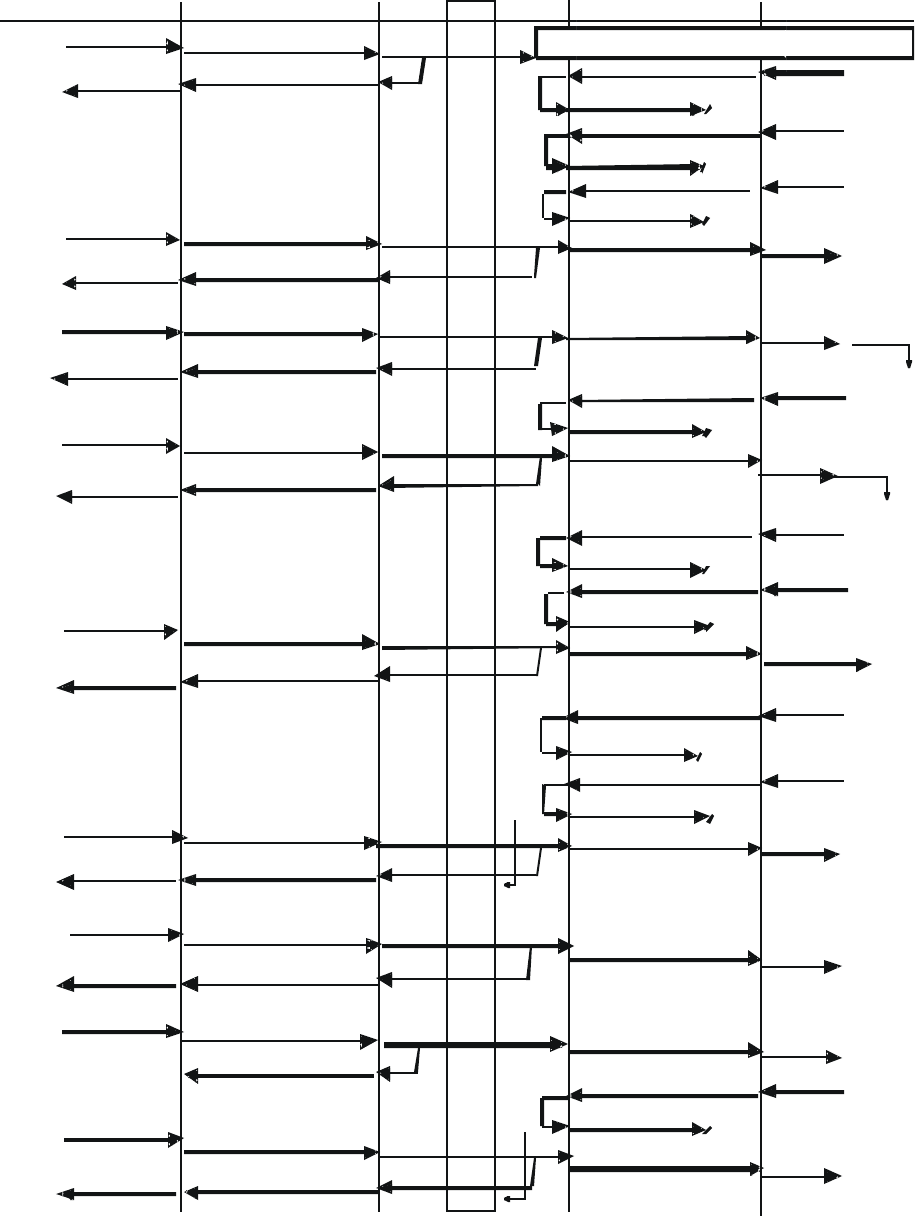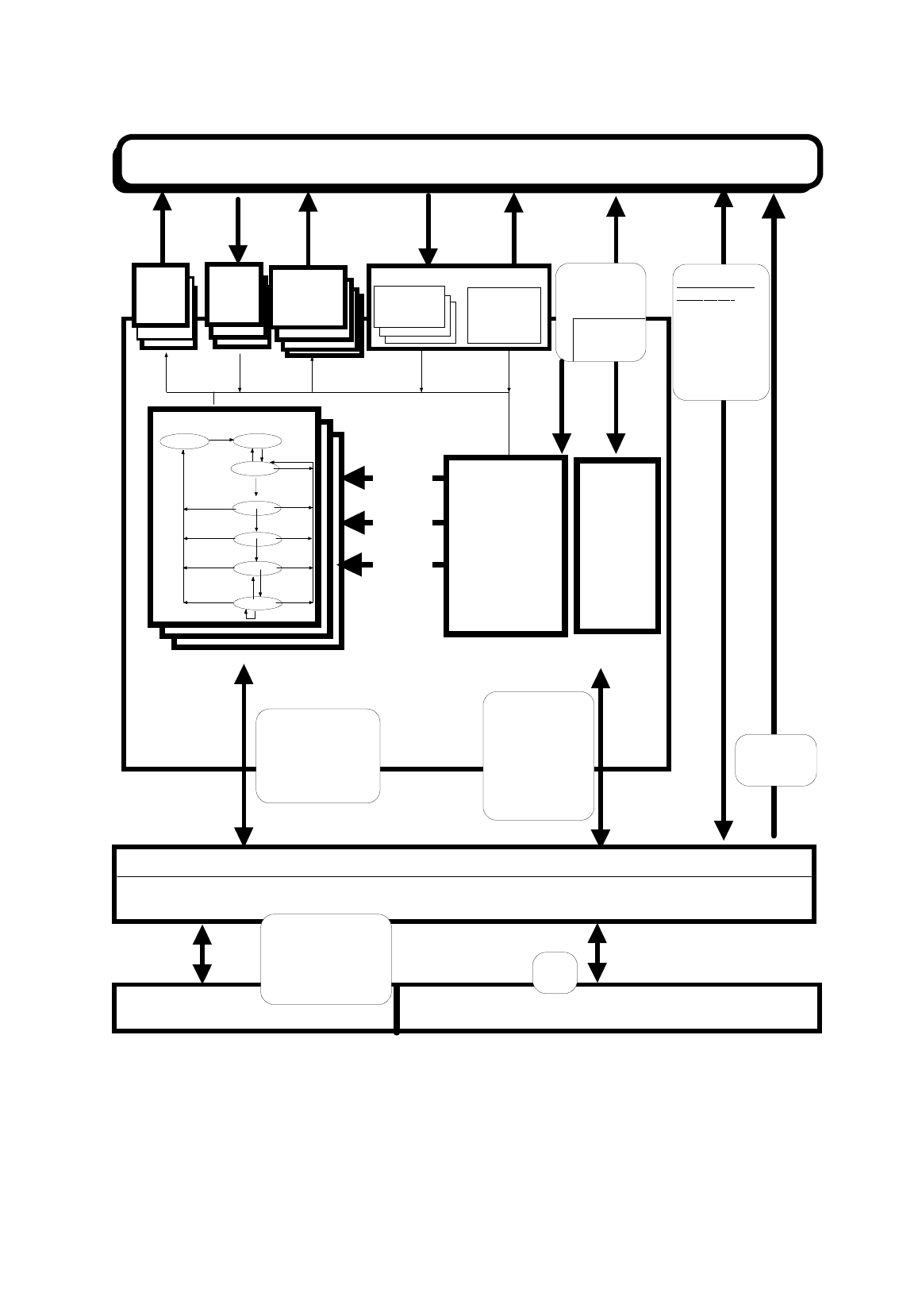Спецификация протокола Profibus
Подождите немного. Документ загружается.


Page 781
PROFIBUS-Specification-Normative-Parts-8:1997
Copyright by PNO 1997 - all rights reserved
b) FMA1/2 services:
- Reset FMA1/2
- Set Value FMA1/2
- Read Value FMA1/2
- Event FMA1/2
- SAP Activate FMA1/2
- RSAP Activate FMA1/2
- SAP Deactivate FMA1/2
The mapping of the DDLM functions to layer 2 and the associated Service Access
Points (SAP) are shown in table 45:
Table 45. Assignment of FDL parameters to the primitives
at master-slave communication
+-------------------------------+-----+-----+----------+---------+
!DDLM_Primitive !SSAP !DSAP !Layer 2 !Serv_ !
! ! ! !Service !class !
+-------------------------------+-----+-----+----------+---------+
! ! ! ! ! !
!DDLM_Data_Exchange.req/.ind !NIL !NIL ! SRD !high !
!DDLM_Data_Exchange.con ! ! ! !low/high !
!DDLM_Data_Exchange_Upd.req ! ! ! !low/high !
! ! ! ! ! !
!DDLM_Chk_Cfg.req/.ind !62 !62 ! SRD !high !
!DDLM_Chk_Cfg.con ! ! ! ! !
! ! ! ! ! !
!DDLM_Set_Prm.req/.ind !62 !61 ! SRD !high !
!DDLM_Set_Prm.con ! ! ! ! !
! ! ! ! ! !
!DDLM_Slave_Diag.req/.ind !62 !60 ! SRD !high !
!DDLM_Slave_Diag.con ! ! ! !low !
!DDLM_Slave_Diag_Upd.req ! ! ! !low !
! ! ! ! ! !
!DDLM_Get_Cfg.req !62 !59 ! SRD !high !
!DDLM_Get_Cfg.con ! ! ! !low !
!DDLM_Get_Cfg_Upd.req ! ! ! !low !
! ! ! ! ! !
!DDLM_Global_Control.req/.ind !62 !58 ! SDN !high !
! ! ! ! ! !
!DDLM_RD_Outp.req !62 !57 ! SRD !high !
!DDLM_RD_Outp.con ! ! ! !low !
!DDLM_RD_Outp_Upd.req ! ! ! !low !
! ! ! ! ! !
!DDLM_RD_Inp.req !62 !56 ! SRD !high !
!DDLM_RD_Inp.con ! ! ! !low !
!DDLM_RD_Inp_Upd.req ! ! ! !low !
! ! ! ! ! !
!DDLM_Set_Slave_Add.req/.ind !62 !55 ! SRD !high !
!DDLM_Set_Slave_Add.con ! ! ! ! !
! ! ! ! ! !
+-------------------------------+-----+-----+----------+---------+

Page 782
PROFIBUS-Specification-Normative-Parts-8:1997
Copyright by PNO 1997 - all rights reserved
Table 46. Assignment of FDL parameters to the primitives
at master-master communication
+-------------------------------+-----+-----+----------+---------+
!DDLM_Primitive !SSAP !DSAP !Layer 2 !Serv_ !
! ! ! !Service !class !
+-------------------------------+-----+-----+----------+---------+
! ! ! ! ! !
!DDLM_xxx.req/.ind !54 !54 ! SRD !low !
!DDLM_xxx.con ! ! ! !low !
!DDLM_xxx_Upd.req ! ! ! !low !
! ! ! ! ! !
!DDLM_Act_Para_Brct.req/.ind !54 !54 ! SDN !low !
!DDLM_Act_Para_Brct.con ! ! ! ! !
! ! ! ! ! !
+-------------------------------+-----+-----+----------+---------+
The functions for master-master communication in the requester and also in the
responder operate all at the Service Access Point 54 (Master-Master-SAP).
12.3 Communication between DP-Master and DP-Slave
The communication between DP-Master and DP-Slave is described in figures 7 to 10
(see section "Master-Slave Communication").
If the DP-Master wants to communicate with a DP-Slave, the DP-Master requests
the Diag_Data of the DP-Slave, in order to check the readiness for operation of
the DP-Slave.
This function request (DDLM_Slave_Diag) will be repeated until the DP-Slave
responds with the requested data.
If the DP-Slave responds with the requested diagnostic information, the DP-
Master checks whether another DP-Master occupies this DP-Slave. If this is not
the case, the DP-Slave will be initialized and configured
(DDLM_Set_Prm/DDLM_Chk_Cfg).
Subsequently the DP-Master requests again the diagnostic data from the DP-Slave.
The following messages can occur:
a) parametrization and configuration error
b) The DP-Slave is occupied by another DP-Master
c) Static user diagnostics, so normal data transfer makes no sense
(for Example: external power supply for the outputs is missing)
d) DP-Slave is not ready for operation
In the cases a) and b) the DP-Master returns to the starting state and checks
again the readiness for operation of the DP-Slave.
In the cases c) and d) the DP-Master requests the diagnostic information from
the DP-Slave until the mentioned messages disappear.
If no error messages occur the DP-Master starts the user data exchange to the
DP-Slave. The input and output data will be transferred to and from the DP-
Slave. The DP-Master (class 1) indicates his own operation mode to the DP-Slaves
for the first time.

Page 783
PROFIBUS-Specification-Normative-Parts-8:1997
Copyright by PNO 1997 - all rights reserved
FDL_DATA_REPLY.req
DDLM _Sla ve_Di ag.req
Responder (Slave)Requester (Master)
FMA1/2_SAP _ACT.req
SRD_REQ_PDU
DDLM_Slave_Init.req
FDL _DAT A_RE PLY. req
DDLM_Set_Prm.con (OK)
SRD_REQ_PDU
S RD_RES_P DU ( Low)
( No_Data)
( PRM_Data) (P RM_Data)
(NR)FDL_DATA_REPLY.con
D DLM_Set_P rm.re q
(PR M_D ata)
FDL_DATA_REPLY.ind
(P RM_Data)
D DLM_ Set_ Prm .i nd
(P RM_Data)
FMA1/2_Set_Value.req
(minTSDR)
FMA1/2_Set_Value.con
DDLM _Set_m inTSDR
(minTSDR)
R eal_Id ent = Exp_Iden t
FD L_DA TA_REPLY.req
DDLM _Ch g_Cfg .con (OK)
SRD_REQ_PDU
SRD_RES_PDU
(C fg_Data)
(Cfg_Data)
DDLM_Chk_Cfg.ind
FDL_DATA_REPLY.in d
(Cfg _D ata)
(C fg_Da ta)
(NR)
FDL_DATA_REPLY.con
( No_Data)
DDLM_Ch k_Cfg .req
(Cfg_ Data)
R eal_C fg = C fg_D ata
FM A1/2 _SAP_ ACT .req
(NIL, 56, 57, 58)
FM A1/2 _SAP _Act.con
DDLM_Enter.req
FDL_REPLY_UPD.req
FDL_REPLY_UPD.con
DDLM _RD_Outp_ Upd. req
DDLM_RD_Inp_Upd.req
DDLM_Data_Exchange.req
DD LM_S lave _ Diag.req
F MA1/ 2_SAP _AC T.con
(55,59,60,61,62)
FDL_R EPLY _UPD ATE.c on
FD L_REPLY_UPDA TE.c on
DDL M_Sl ave_D iag_ Upd.req
F DL_ REPLY_UP DATE.req
(D iag_Data)
FDL_REPLY_UPDATE.con
(Input_Data)
FDL_DATA_REPLY.ind
FDL_DATA_REPLY.req
(O utput_Dat a = 0)
FDL_DATA_REPLY.con
(Output_Data = 0)
(Output_Data =0)
SRD_REQ _PDU
S RD_R ES_P DU
( In p u t_Da ta)
(Ou tput_D ata = 0)
FDL_DATA_REPLY.req
D DLM_Slav e_Dia g.ind
FDL_DATA_REPLY.in d
FDL_REPLY_UPDATE.req
(Inpu t_Data)
DDL M_
Data_Exchang e_Up d.req
(Input_D ata)
FDL_DATA_REPLY.req
(Dia g_Dat a, Low )
FDL_DATA_REPLY.co n
DDLM _Slave_Diag.req
FDL_DATA_REPLY.ind
D DLM _Slav e_D iag. ind
SRD_REQ_PDU
SR D_RES_PD U (Low)
( Diag_Data)
SRD_REQ_PDU
S RD_R ES_P DU (Low)
( Diag_ Data)
D DLM _Get _Cfg_Upd.req
(C fg_Data)
FDL_REPLY_UPDATE.req
(Cf g_D a ta)
F DL_R EPLY_U PD ATE. con
D DLM_Slav e_Dia g.ind
(Diag_ Data, Low)
DD LM_Slave _Diag .req
FDL _DATA_REPLY.req
FD L_DATA_REPLY.con
SRD_REQ_PDU
SRD_RE S_P DU (L ow)
( D iag_D ata)
FDL_DATA_REPLY.ind
FDL_R EPL Y_UP DATE .req
(Diag_Data)
D DLM _Slav e_Dia g_Upd.req
(Station_Not_Ready = False)
D DLM _D ata _Exch ang e. ind
(Ou tput_Data = 0)
DD LM_S lave_ Diag.c on
(Diag_D ata, Low
Sta tion_Not_R eady = Tru e)
DD LM_S lave_Diag.con
(Dia g_Da ta, Lo w
Station_Not_R eady = Fals e)
(Input_Data)
DDLM_Data_Exchange.con
(S tation_Not _Read y = Tru e)
Slave not yet ready for operation
DD LM_Slave _Diag .con
(Diag _D ata, Low
Station_ Not_R eady = Tru e)
DD LM_D ata_Exchange.req
D DLM _Data _Exc hang e.ind
FD L_D ATA_REPL Y.ind
FDL_DATA_REPLY.req
(Output_Data)
FDL_DATA_REPLY.con
(Out put_D ata)
( Output_Da ta)
(Output_Data)
SRD_REQ _PDU
SRD_RES_PDU
( In pu t_D ata)
(O utpu t_D ata)
(Input_Data)
DDLM_Data_Exchange.con
DDLM_ Global_Control.req
FDL _DAT A.ind
FDL _DAT A.req
SDN_REQ_PDU
FDL_DATA _REP LY.con (N A)
DD LM_S lave_ Diag .con (NA )
FDL_DATA.con
DD LM_ Globa l_C ontrol. con
FD L_REPLY _UPD ATE.re q
(In put_D ata)
FD L_RE PLY_U PDA TE.c on
Store
Data
(In pu t_Data)
(Diag_Data, Low)
FDL_DATA_REPLY.con
User-Interface
DDLM FDL Bus FDL DDLM U ser-Interface
Store
Dia g_
Dat a
Store
Cfg_
Dat a
Stor e
Inp_
Data
Sto re
Diag _
Dat a
DD L M_ G lob al_Co nt rol .ind
DD LM _
Data _Exc hange _U pd .req
Figure 29. Sequence of the communication between DP-Master and DP-Slave

Page 784
PROFIBUS-Specification-Normative-Parts-8:1997
Copyright by PNO 1997 - all rights reserved
12.4 Communication between DP-Master and DP-Master
The communication between DP-Master (class 2) and DP-Master (class 1) is handled
in a fixed way (see figure 30) with one exception.
This exception is the function DDLM_Act_Para_Brct, which is transferred as a
multicast from the DP-Master (class 2) to the corresponding DP-Master (class 1).
Communication is always initiated by the DP-Master (class 2). The DP-Master
(class 2) sends a request to the DP-Master (class 1) and waits for the response.
The service is processed by the DDLM of the DP-Master (class 2). After the
receipt of the response the DP-Master (class 2) can make a new request.
At one point of time the DP-Master (class 1) can only communicate with one DP-
Master (class 2).
The DP-Master communication is initiated by a DDLM_xxx.req (see also section
"DP-Master - DP-Master Functions") from the DP-Master (class 2). The DDLM passes
this request to layer 2 and checks the SRD_RES_PDU after receipt of the
response. If the response status is NR (no reply data) it will retry once more
with a new SRD with no L_sdu to get response data. This procedure will be
repeated by the DP-Master (class 2) until
- an erroneous SRD_RES_PDU
- or a SRD_RES_PDU with response data is received,
- or the watchdog T1 expires.
The result will then be passed to the User of the DP-Master (class 2) by means
of a corresponding DDLM_xxx.con.
The timer T1 will be started after receipt of the DDLM_xxx.req in the DDLM of
the DP-Master (class 2) and will be stopped after release of the DDLM_xxx.con.
The value loaded in the timer T1 depends on the FDL parameter and the
performance of the DP-Master (class 1).
The responder (DP-Master (class 1)) waits after a reset for a request. If the
DDLM of the DP-Master (class 1) receives a valid request, this request is passed
to the user by the corresponding DDLM_xxx.ind. At this point of time an access
protection was set to the local service access point (SAP) for the communication
with the DP-Master (class 2). This is necessary to make sure that the response
data will be sent to the right DP-Master (class 2).
After receipt of the response from the user (DDLM_xxx.res) the response data
will be passed with a FDL_REPLY_UPDATE.req to layer 2. Additionally, a timer
will be started which controls the request for the response. If this timer
expires and the response data are still not fetched by the DP-Master (class 2),
the DDLM deletes the response data because the DDLM presumes that the DP-Master
(class 2) is no longer available. In this case the access protection for the DP-
Master (class 2) will be cancelled. This will also be done in the case of a
single transaction if a FDL_DATA_REPLY.ind indicates that the response data are
fetched by the DP-Master (class 2). The value loaded in the timer of the DP-
Master (class 1) depends on the FDL parameter and the performance of the DP-
Master (class 2).
In case of master-master communication a sequence of requests can put into
parentheses. Therefore the access protection will be set by the "DDLM_Start_Seq"
and released by the "DDLM_End_Seq". To avoid errors the time between two
requests will be supervised. The value for the time supervision is added to the
DDLM_Start_Seq request. With the DDLM_Start_Seq.req the user can additionally
send an areacode. By means of this areacode at the beginning of a sequence an
area can be reserved at the user in the DP-Master (class 1).

Page 785
PROFIBUS-Specification-Normative-Parts-8:1997
Copyright by PNO 1997 - all rights reserved
DDLM_Function.req
FDL_DATA_REPLY.ind
Responder (DP-Master (Class 1))Requester (DP-Master (Class 2))
FDL_DATA_REPLY.req
(Function.ind)
FDL_DATA_REPLY.con
(no Data)
(Function_REQ_PDU)
SRD_REQ_PDU
SRD_RES_PDU
( no Data)
(Function.res)
DDLM_Function.con
(Data)
Store
Data
FMA1/2_RSAP_ACT.req
(Access = All)
FMA1/2_RSAP_ACT.con
DDLM_Function.res
(Data)
FDL_REPLY_UPD.req
(Data)
FDL_REPLY_UPD.con
FMA1/2_RSAP_ACT.req
(Access = Rem_add)
FMA1/2_RSAP_ACT.con
DDLM_Function.ind
FDL_DATA_REPLY.ind
SRD_REQ_PDU
(no Data)
SRD_RES_PDU
(Function.res)
FDL_DATA_REPLY.req
(no Data)
FDL_DATA_REPLY.con
FDL_DATA_REPLY.req
(no Data)
FDL_DATA_REPLY.con
(no Data)
SRD_REQ_PDU
SRD_RES_PDU
(no Data)
(no Data)
(Function.req)
User DDLM FDL Bus FDL DDLM User
The following cycle will be repeated depending on
the time for reaction of the responder 0 ...n -times
Control time (T1) in the
DDLM of the Responder
for the Requester
Control time (T1) in the
DDLM at the Requester
Control time (T1) in the
DDLM of the Responder
for the User
Time for reaction
at the Responder
Figure 30. Sequence of communication between DP-Master (class˚2)
and DP-Master (class˚1)

Page 786
PROFIBUS-Specification-Normative-Parts-8:1997
Copyright by PNO 1997 - all rights reserved
13 Formal Description of State Machines
13.1 General
The formal description is based upon a model. This model describes the DP
protocol with the help of state machines (represented by state diagrams). The
protocol sequences are described by different states (represented by ellipses
with the name of the state) and transitions between states (represented by lines
with arrows). State changes are caused by events (for Example time out) combined
with conditions. The state changes in turn lead to actions or reactions.
The formal description follows the description of the LLI state machines in the
PROFIBUS Specification. This description is based on an abstract model and it is
not the intention of the model to prescribe the translation in a concrete
realization.
13.2 Communication Model of DP-Master (Class 1)
13.2.1 General
The DP-Master (class 1) is subdivided in 4 instances:
1. layer 1/2, Subset of PROFIBUS (FDL and FMA1/2)
2. Direct-Data-Link-Mapper (DDLM)
3. User-Interface
4. User
An overview of the interactions between the individual instances is given in
figure 31.
13.2.2 FDL and FMA1/2
The layer 2 has to handle at least the FDL services SRD and SDN. In addition to
the services Reset FMA1/2 and Event FMA1/2 the service SAP Activate FMA1/2 is
also mandatory. To enable the communication with a DP-Master (class 2), it is
necessary to additionally implement the SRD-/SDN-responder functions and the
service RSAP Activate FMA1/2. In this case layer 2 must be able to handle SAP
access protection and Reply-Update-Mode = single.
Additional hints are given in the sections "Transmission Technology" and "Medium
Access and Transmission Protocol".
13.2.3 Direct-Data-Link-Mapper
The DDLM contains a mapping of the DDLM functions onto the layer 2 services.
For the DDLM of the DP-Master (class 1) the following local functions are
mandatory:
-DDLM_Master_Init
-DDLM_Responder_Init
-DDLM_Fault
-DDLM_Event

Page 787
PROFIBUS-Specification-Normative-Parts-8:1997
Copyright by PNO 1997 - all rights reserved
Additionally the following data transmission functions are also mandatory:
-DDLM_Slave_Diag
-DDLM_Set_Prm
-DDLM_Chk_Cfg
-DDLM_Data_Exchange
-DDLM_Global_Control
With these functions the User-Interface carries out the data exchange with the
DP-Slaves.
In case of communication between a DP-Master (class 2) and a DP-Master (class 1)
the DDLM works transaction oriented. The DP-Master (class 1) can at one point of
time communicate with at most one DP-Master (class 2). It is not allowed to have
parallel services active.
The DP-Master (class 2) initiates these functions for the master-master
communication. It is not necessary for the DP-Master (class 1) to confirm these
functions with an immediate response. In this case the DP-Master (class 2) polls
the DP-Master (class 1) until the DP-Master (class 1) provides the response data
(see figure 30).
For the DDLM of the DP-Master (class 1) the following function is mandatory:
-DDLM_Get_Master_Diag
The DDLM provides optionally the following functions for the master- master
communication:
-DDLM_Start_Seq
-DDLM_End_Seq
-DDLM_Upload
-DDLM_Download
-DDLM_Act_Para_Brct
-DDLM_Act_Param
13.2.4 User-Interface
The User-Interface communicates with the DDLM using the functions as described
in the sections before.
The interface to the user is formed as a data and service interface. The
interface between user and User-Interface of the DP-Master (class 1) is
described in detail in section "DP-Master (class 1)".
The User-Interface consists of three function blocks:
- Slave-Handler
- Scheduler
- Service-Handler
The state machine of the Slave-Handler takes over the control of exactly one DP-
Slave. The management of each DP-Slave is made independently. The state machines
for each DP-Slave react individually depending on the state of the DP-Slave.
The DP-Slaves are processed following a fixed sequence. At each call the
corresponding Slave-Handler will make only one DDLM request. The Scheduler
determines the sequence of the calls of the corresponding Slave-Handlers (and
therefore the sequence of telegrams on the network). A given period of time
between two slave poll cycles has to be secured by the Scheduler. This period of
time (Min_Slave_Interval) is stored in the master parameter set. This time
depends on the performance of the used DP-Slaves in a given system.

Page 788
PROFIBUS-Specification-Normative-Parts-8:1997
Copyright by PNO 1997 - all rights reserved
The Scheduler additionally has to initialize the DDLM and to reset the Slave-
Handlers at power up. Locally generated events and errors from FDL and DDLM are
evaluated by the Scheduler, too.
The Scheduler also controls the global state transitions:
- Offline:
The User-Interface carries out no actions, DDLM functions are
suspended.
- Stop:
The Slave-Handlers are locked, DDLM functions for master- master
communication (e. g. to load the parameters) are handled.
- Clear:
The Slave-Handlers are active, output data equal to zero are
transferred to the DP-Slaves.
- Operate:
The Slave-Handlers are active, the output data from the user are
transferred to the DP-Slaves.
The User-Interface takes over protective functions (Auto-Clear), if a DP-Slave
breaks down during operation. The Scheduler clears the outputs of the DP-Slaves
if the Error_Action_Flag is set and changes the operation mode to the state
"Clear". This change of the operation mode will not take place if the
Error_Action_Flag in the bus parameter set is not set.
The Mark function supports the user to handle the Sync and Freeze control
commands. This function gives the user the possibility to wait for a complete
slave poll cycle after which a defined transfer of input and output data can
take place.
The Service-Handler takes over the control for the local functions Load_Bus_Par,
Read_Value and Delete_SC.
13.2.5 User
The user represents the real application process of the corresponding device and
has to be defined depending on the application.

Page 789
PROFIBUS-Specification-Normative-Parts-8:1997
Copyright by PNO 1997 - all rights reserved
Load_Bus_Par
User
DDLM
Local functions and Datatransfer-functions
FMA1/2
FDL
SDN
SRD
Slave_Dia
g
Set_Prm
Chk_Cf
g
Data_Exchan
g
e
Master-Parameterset
Bus-
Parameterset
Master-Master-
Functions:
Get_Master_Dia
g
Start_Seq
End_Seq
Upload
Download
Act_Param
Event
User-Interface
Input_
Data
Slave-
Parameterset
Set_Mode
Global_Control
Mode_Chan
g
ed
Mark
Read_Value
Delet_SC
Master_Init
Global_Control
Reset
Responder_Init
Fault
Read_Value
Delete_SC
Start
Stop
Continue
USIF
Scheduler
USIF-STATE:
- Offline
- Stop
- Clear
- Operate
Service_
Handler
RESET, EVENT
RSAP ACTIVATE
SET VALUE
SAP ACTIVATE
READ VALUE
Act_Para_Brct
Set_Bus_Par
Output_
Data
Diagnostic_
Data
Slave_Handler
DEACT
UNLCK
DATA
PRM
CFG
DIAG2
DIAG1
Figure 31. Structure of a DP-Master (class 1)

Page 790
PROFIBUS-Specification-Normative-Parts-8:1997
Copyright by PNO 1997 - all rights reserved
13.3 State Machines in the DP-Master (Master-Slave)
13.3.1 State Machine Slave-Handler
13.3.1.1 State Diagram Slave-Handler
WDATA
OK1
OK2
OK3
WPRM
WCFG
WDIAG2
EXD1
STOP
Power_On
DEACT
OK0
DIAG1
WDIAG1
PRM
CFG
DIAG2
DATA
UNLCK
WUNLCK
SUNLCK
WAIT1
WAIT2
INI1
WAIT3
INI2
STOP1
CONT1
NA0,RE0
DS0,LOCK
DEA0
DEA1
DEA2
DEA3
ERR0,DEA4,5
CONT2
STOP2
DS1
NA1,RE1
STOP3
CONT3
DS2
NA2,RE2
CONT4
STOP4
DS3,NA3,WT0
RE3,RJ0
CONT5,6,7
STOP5
DIAG1
DIAG2
RE4,5
STOP6
STOP7
CONT8
UNLCK2
UNLCK1
FATAL1
OK4,5 DS4,5
NA4,5
Figure 32. State Diagram of the Slave-Handler
